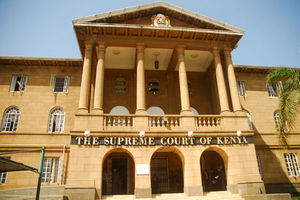
Within the judiciary, the explanation proffered for the comparatively lacklustre performance of the superior courts is that they handle more weighty cases than the magistrates.
Easter, in a temporal sense, is a stark reminder of the consequences that accrue from the miscarriage of justice. An innocent man was framed on political charges and executed because someone exercising judicial authority literally washed his hands off the affair—and the world has never been the same. It is, therefore, apposite to reflect on the state of justice in Kenya, especially because judges traditionally take a break during Easter.
Statistics from the most recent State of the Judiciary and Administration of Justice report show that the number of pending cases in 2023/24 rose from 625,643 to 649,310 but that the backlog of cases older than five years reduced by 10 per cent. It sounds like a good result, but people’s lived experiences provide a contrasting picture. Public frustration has been mounting over delaying tactics by some of the superior courts when faced with difficult political decisions.
High Court
Three recent examples illustrate this: Chief Justice David Maraga’s advisory to the President to dissolve Parliament for not passing laws to give effect to the “not-more-than-two-thirds” gender rule was challenged in court. The petition is stuck somewhere between the High Court and the Court of Appeal. The attempt by some senior lawyers to initiate the removal of all Supreme Court judges is stuck in the High Court.
And a constitutional petition filed in July last year seeking a declaration that President William Ruto has violated the Constitution more than 31 times has not even been sent to the Chief Justice to empanel a bench of uneven number of judges. The epidemic of strategic judging—where sensitive cases are kicked down the road until they are no longer politically explosive—is alive and well over 2,000 years since Pontius Pilate.
There is only one reason why the courts numbers look good: over 90 per cent of the caseload in the Judiciary is handled in the magistrates and Kadhis’ courts. Each magistrate on average handles 1,558 cases each year, and the highest manages 4,000. An analysis of court data by the Institute of Economic Affairs found that in 2021, each magistrate closed a remarkable 257 cases per year.
Magistrates successfully closed 308,482 cases. The rest of the Judiciary closed 50,420 cases that year. The High Court, supported by 200 staff, resolved 34,371 cases with about 172 cases per judge, followed 131 cases per judge on the Environment and Land Court and 120 cases per judge in the Employment and Labour Relations Court.
Sh25 billion
At the present count, there are 614 magistrates and 52 Kadhis in Kenya. It is only half of the approved establishment. The country cannot hire more magistrates because the budget allocation of Sh25 billion—half of what Parliament, with its just over 400 members—receives.
Within the judiciary, the explanation proffered for the comparatively lacklustre performance of the superior courts is that they handle more weighty cases than the magistrates. During a recent magistrates and Kadhis colloquium, evidence was presented that should retire this myth once and for all. Of the 18,637 decisions from magistrates’ courts that were appealed between 2021 and 2025, some 86.8 per cent were upheld or affirmed in the High Court and the Court of Appeal. The High Court dismissed nearly half of all the appeals on decisions from the magistrates’ courts. Of the 1,010 cases that went to the Court of Appeal, 85.5 per cent were dismissed.
Legal researcher Njeri Githang’a concludes that these statistics speak of consistency and confidence in the magistrates’ courts and confirm that the system of appeals works. The decisions of the lower courts align with those of the superior courts. There is a high degree of accuracy and soundness of legal reasoning emerging from the lower courts. Magistrates have been laying the foundation for what become the big jurisprudential cases. Legal reporting does not so far capture the magistrates’ contribution to jurisprudence, but a review of important appeal decisions shows that the original genius emerged in the magistrates’ courts.
Magistrates took the first bite of the Ferdinand Waititu case when they ruled that barring a governor from accessing their office pending prosecution on corruption charges does not amount to removal from office. It is a Supreme Court precedent. They highlighted the need for legal reforms on the mandatory death penalty in capital offences other than the offence of murder.
It is in the lower courts where the justice needs of the majority of Kenyans are served. Magistrates have acquitted themselves with aplomb. They are what former Chief Justice Willy Mutunga called the “Missionaries of Justice”. They do not have bodyguards and live within communities. Previously, magistrates attending interviews for promotion to judgeship would come up short on arcane issues of law and procedure, but this belies the reality of what they actually do. They are better trained and have at least three years in practice. Many of them hold second degrees and quite a few are in doctoral programmes.
Judges can learn a thing or two from magistrates—who have been living the dream of delivering people-centred justice as envisioned in the Social Transformation Through Access to Justice blueprint.
The writer is a board member of KHRC and writes in his individual capacity. @kwamchetsi; kwamchetsi@email.com.









